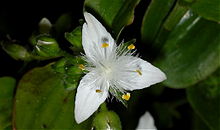Tradescantia fluminensis
| Tradescantia fluminensis | |
|---|---|
 |
|
| Scientific classification | |
| Kingdom: | Plantae |
| (unranked): | Angiosperms |
| (unranked): | Monocots |
| (unranked): | Commelinids |
| Order: | Commelinales |
| Family: | Commelinaceae |
| Genus: | Tradescantia |
| Species: | T. fluminensis |
| Binomial name | |
|
Tradescantia fluminensis Vell. |
|
| Synonyms | |
|
Tradescantia albiflora |
|
Tradescantia albiflora
Tradescantia fluminensis is a species of spiderwort native to South America. It is one of several plants known by the common name . It is also known as small-leaf spiderwort,river spiderwort, inch plant, wandering trad, wandering willie, wandering gypsy.
Tradescantia fluminensis is a perennial ground cover that spreads along the ground with soft, hairless stems and leaves. The fleshy stems root at any node that is on the surface. The plant has oval, dark-green leaves with pointed tips that are shiny, smooth and slightly fleshy about 1.25 – 2.5 inches long. The flowers are white with three petals and approx. 0.5 – 1-inch in diameter. They are produced in small clusters in summer but do not produce seeds.
Tradescantia fluminensis is grown as a garden plant or houseplant in many places. Even in places where it is a pest it may be grown as a house plant in variegated forms. The plant requires a moist soil to do well but is retarded by cold climates, especially where there is frost or snow. It tolerates heavy shade. Because it requires moisture it grows weakly, if at all, in sunny areas that dry out for long periods. However, because it is a fleshy plant that retains water, it can withstand extended periods of dryness only to resume growth once better conditions return.
Numerous cultivars are available with variegated leaves, of which 'Quicksilver' has gained the Royal Horticultural Society's Award of Garden Merit.
Tradescantia fluminensis is considered an invasive species, noxious weed, or pest plant in many places and is consequently targeted for eradication. Seriously affected areas include Australia,New Zealand, and the southeastern United States.
It is classified as a Category 1b Invasive Species in South Africa, and thus in South Africa it may no longer be planted, propagated, or be allowed to disperse, and all trade in their seeds, cuttings or other propagative material is prohibited, in both rural and urban areas.
The seriously invasive qualities of T. fluminensis result from a combination of attributes. Forming a dense mat underneath forest tree cover to 12 inches (30 centimeters) or even more (facilitated by a remarkable shade tolerance) it smothers ground-level plants and prevents the natural regeneration of taller species and if left unchecked, it can lead to the destruction of native forests. Even where the climate does not permit T. fluminensis to take root, it still can spread rapidly from being transported by animals and humans and even strong winds. The succulent stems break easily at the nodes and establish themselves wherever they land on moist soil. While T. fluminensis does respond to herbicides and other applied weed controls, each segment has the ability to regenerate, so it is able to make a rapid comeback, especially in soft soils where stems may remain underneath the surface.
...
Wikipedia
